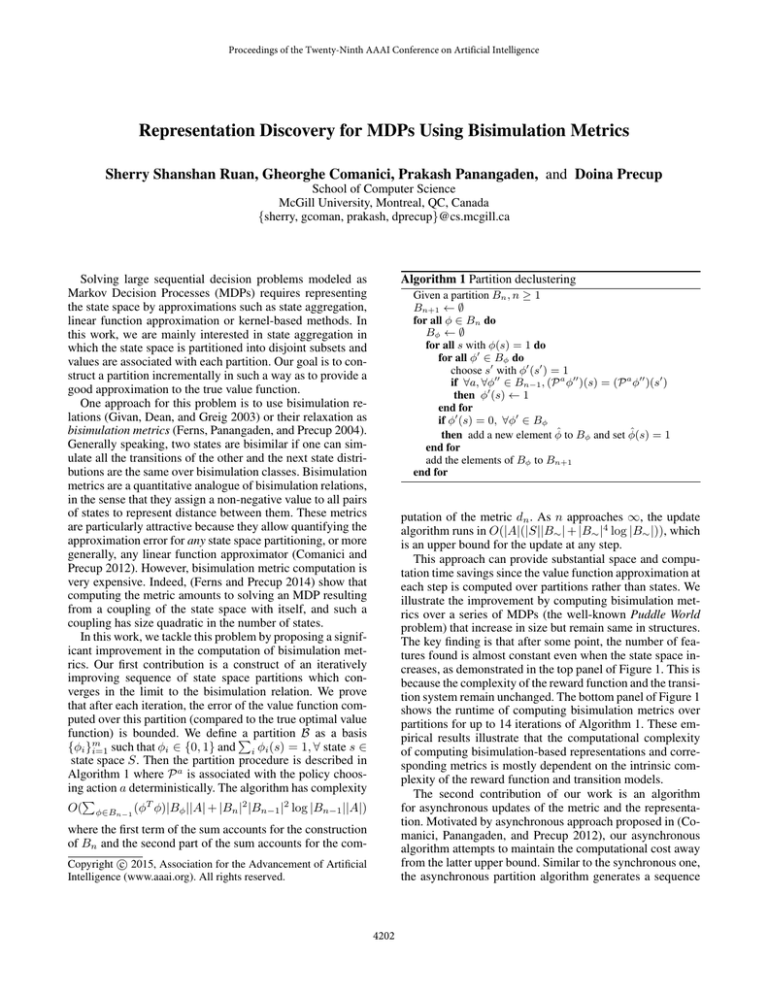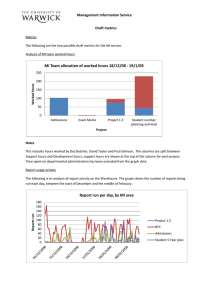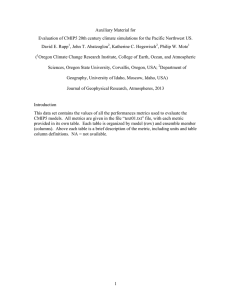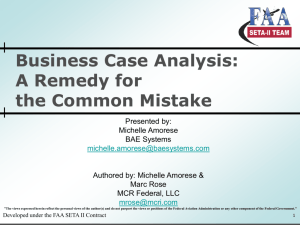
Proceedings of the Twenty-Ninth AAAI Conference on Artificial Intelligence
Representation Discovery for MDPs Using Bisimulation Metrics
Sherry Shanshan Ruan, Gheorghe Comanici, Prakash Panangaden, and Doina Precup
School of Computer Science
McGill University, Montreal, QC, Canada
{sherry, gcoman, prakash, dprecup}@cs.mcgill.ca
Algorithm 1 Partition declustering
Solving large sequential decision problems modeled as
Markov Decision Processes (MDPs) requires representing
the state space by approximations such as state aggregation,
linear function approximation or kernel-based methods. In
this work, we are mainly interested in state aggregation in
which the state space is partitioned into disjoint subsets and
values are associated with each partition. Our goal is to construct a partition incrementally in such a way as to provide a
good approximation to the true value function.
One approach for this problem is to use bisimulation relations (Givan, Dean, and Greig 2003) or their relaxation as
bisimulation metrics (Ferns, Panangaden, and Precup 2004).
Generally speaking, two states are bisimilar if one can simulate all the transitions of the other and the next state distributions are the same over bisimulation classes. Bisimulation
metrics are a quantitative analogue of bisimulation relations,
in the sense that they assign a non-negative value to all pairs
of states to represent distance between them. These metrics
are particularly attractive because they allow quantifying the
approximation error for any state space partitioning, or more
generally, any linear function approximator (Comanici and
Precup 2012). However, bisimulation metric computation is
very expensive. Indeed, (Ferns and Precup 2014) show that
computing the metric amounts to solving an MDP resulting
from a coupling of the state space with itself, and such a
coupling has size quadratic in the number of states.
In this work, we tackle this problem by proposing a significant improvement in the computation of bisimulation metrics. Our first contribution is a construct of an iteratively
improving sequence of state space partitions which converges in the limit to the bisimulation relation. We prove
that after each iteration, the error of the value function computed over this partition (compared to the true optimal value
function) is bounded. We define P
a partition B as a basis
{φi }m
such
that
φ
∈
{0,
1}
and
i
i=1
i φi (s) = 1, ∀ state s ∈
state space S. Then the partition procedure is described in
Algorithm 1 where P a is associated with the policy choosing action a deterministically. The algorithm has complexity
P
O( φ∈Bn−1 (φT φ)|Bφ ||A| + |Bn |2 |Bn−1 |2 log |Bn−1 ||A|)
Given a partition Bn , n ≥ 1
Bn+1 ← ∅
for all φ ∈ Bn do
Bφ ← ∅
for all s with φ(s) = 1 do
for all φ0 ∈ Bφ do
choose s0 with φ0 (s0 ) = 1
if ∀a, ∀φ00 ∈ Bn−1 , (P a φ00 )(s) = (P a φ00 )(s0 )
then φ0 (s) ← 1
end for
if φ0 (s) = 0, ∀φ0 ∈ Bφ
then add a new element φ̂ to Bφ and set φ̂(s) = 1
end for
add the elements of Bφ to Bn+1
end for
putation of the metric dn . As n approaches ∞, the update
algorithm runs in O(|A|(|S||B∼ | + |B∼ |4 log |B∼ |)), which
is an upper bound for the update at any step.
This approach can provide substantial space and computation time savings since the value function approximation at
each step is computed over partitions rather than states. We
illustrate the improvement by computing bisimulation metrics over a series of MDPs (the well-known Puddle World
problem) that increase in size but remain same in structures.
The key finding is that after some point, the number of features found is almost constant even when the state space increases, as demonstrated in the top panel of Figure 1. This is
because the complexity of the reward function and the transition system remain unchanged. The bottom panel of Figure 1
shows the runtime of computing bisimulation metrics over
partitions for up to 14 iterations of Algorithm 1. These empirical results illustrate that the computational complexity
of computing bisimulation-based representations and corresponding metrics is mostly dependent on the intrinsic complexity of the reward function and transition models.
The second contribution of our work is an algorithm
for asynchronous updates of the metric and the representation. Motivated by asynchronous approach proposed in (Comanici, Panangaden, and Precup 2012), our asynchronous
algorithm attempts to maintain the computational cost away
from the latter upper bound. Similar to the synchronous one,
the asynchronous partition algorithm generates a sequence
where the first term of the sum accounts for the construction
of Bn and the second part of the sum accounts for the comc 2015, Association for the Advancement of Artificial
Copyright Intelligence (www.aaai.org). All rights reserved.
4202
Figure 2: Asynchronous computation: A plot of the approximation error in the value function computation (L∞ norm) as the size
of the alternative representation is increased. This particular plot
was generated on a Puddle World of size 4900.
of time and memory usage, and more flexibility in terms of
guiding the search for alternative state space representations
for MDPs. As illustrated, the methods we propose are barely
as sensitive to the size of the state space of the problem.
The approach presented in this paper opens the door to
more specialized strategies to finding bisimulation-based
MDP representations. We illustrated the advantage of using
heuristic based search strategies, but the strategy we used
(which attempts to keep the size of state partitions roughly
the same) is very simple, and it is likely that more sophisticated approaches would work better. For example, one could
try strategies similar to prioritized sweeping, which focus on
areas of the state space where the metric is changing drastically. Investigating more sophisticated heuristics and applying them to larger problems is a worthwhile approach for
future work.
Figure 1: Puddle World - computing the metric. Top: A plot of
the runtime as a function of state space size when computing the
metric. If metrics are computed over the state space instead, the
runtime jumps from 129 seconds on a 400 states environment, to
1375 seconds when the number of states is 1600. Bottom: The
number of features in the intermediate steps of the algorithm. Note
that for state spaces larger than 4900, the number of features does
not change substantially with the size of the space.
of partitions and metric over them with the property that the
corresponding metrics can be transformed to a sequence of
metrics converging to the desired Kantorovich-based fixed
point bisimulation metric. We provide theoretical conditions
which allow computational effort to be focused on parts of
the state space where changes are happening rapidly, similar
to successful asynchronous or distributed dynamic programming techniques such as (Bertsekas and Tsitsiklis 1996).
To assess the importance of the asynchronous partition
and metric update, we fixed the size of the Puddle World and
compared the value function approximation error as a function of the size of intermediate representations. For each partition we performed dynamic programming to compute the
value function and used a heuristic which selects the largest
block first to update the partition and metric. This comes
from the intuition that it would be desirable to seek a representation that is as uniform as possible. As can be seen
in Figure 2, the asynchronous algorithm reaches representations of higher quality at much earlier stages of the iterative framework. This empirical result illustrates the use of
heuristics can substantially speed up the computation.
In conclusion, we presented two new ways of describing
bisimulation metrics from a theoretical perspective, and we
used these to design novel iterative refinement algorithms.
These algorithms provide substantial improvement in terms
References
Bertsekas, D. P., and Tsitsiklis, J. N. 1996. Neuro-Dynamic
Programming. Athena Scientific, Bellman, MA.
Comanici, G., and Precup, D. 2012. Basis function discovery
using spectral clustering and bisimulation metrics. In Lecture
Notes in Computer Science, Volume 7113.
Comanici, G.; Panangaden, P.; and Precup, D. 2012. On-thefly algorithms for bisimulation metrics. In the 9th International
Conference on Quantitative Evaluation of SysTems (QEST).
Ferns, N., and Precup, D. 2014. Bisimulation metrics are optimal value functions. In the 30th Conference on Uncertainty in
Artificial Intelligence.
Ferns, N.; Panangaden, P.; and Precup, D. 2004. Metrics for
finite Markov decision precesses. In the 20th Conference on
Uncertainty in Artificial Intelligence, 162–169.
Givan, R.; Dean, T.; and Greig, M. 2003. Equivalence notions
and model minimization in Markov decision processes. Artificial Intelligence 147(1-2):163–223.
4203







